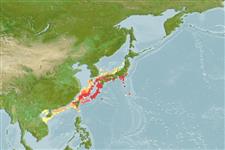>
Acropomatiformes (Oceanic basses) >
Creediidae (Sandburrowers)
Etymology: Myopsaron: Name from the Greek words 'mys' meaning mouse and 'opsaron' for a little fish, referring to its unique globular-shaped fleshy extension at tip of upper jaw, resembling the nose of mouse.; nelsoni: Named for J. S. Nelson, for his great contribution to our knowledge about taxonomy and systematics of the creediine fishes..
Environment: milieu / climate zone / depth range / distribution range
Ecología
marino; rango de profundidad 51 - 99 m (Ref. 84004). Subtropical
Northwest Pacific: Ogasawara Islands, Japan.
Tamaño / Peso / Age
Maturity: Lm ? range ? - ? cm
Max length : 3.6 cm SL macho / no sexado; (Ref. 84004)
Short description
Morfología | Morfometría
Radios blandos dorsales (total): 14-16; Radios blandos anales: 16 - 18; Vértebra: 43 - 45. This species is unique in having the following characters: a globular fleshy extension at tip of upper jaw; lateral line divided into 2 parts, with 3 (rarely 2 or 4) grooved scales in the anterior series and 33-35 pored scales with distinct posterior lobe in the posterior series; higher counts of precaudal vertebrae than caudal vertebrae (24-26 + 18-21 = 43-45); edentate premaxilla; D 14-16; A 16-18; dorsal- and anal-fin rays 30-34, both fins restricted to posterior half of body; anal-fin origin below first to third dorsal-fin rays; pelvic-fin I,3-4 (almost always I,3); fourth pectoral- and first pelvic-fin rays greatly elongated and filamentous in male; all dorsal-, anal-, pectoral- and pelvic-fin segmented rays unbranched; caudal-fin rays 9 branched; anal-fin pterygiophores 1 (rarely two) anterior to first haemal spine; vomer and palatine teeth absent, 1 to 3 minute conical teeth on middle of dentary; epurals 2; both anterior and posterior nares pore-like; suborbital skin fold discontinuous at midway; infraorbital canal shortly interrupted below eye; mandibular canal not joined with preopercular canal (Ref. 84004).
Collected by sledge nets from flat sandy bottoms off its type locality (Ref. 84004).
Life cycle and mating behavior
Madurez | Reproducción | Puesta | Huevos | Fecundidad | Larva
Shibukawa, K., 2010. Myopsaron nelsoni, a new genus and species of sandburrowers (Perciformes: Trichonotidae: Creediinae) from the Ogasawara Islands, Japan. Bull. Natl. Mus. Nat. Sci., Ser. A, (Suppl. 4):49-66. (Ref. 84004)
IUCN Red List Status (Ref. 130435)
Threat to humans
Harmless
Human uses
Más información
Nombres comunesSinónimosMetabolismoDespredadoresEcotoxicologíaReproducciónMadurezPuestaAgregación para la puestaFecundidadHuevosEgg development
Age/SizeCrecimientoLength-weightLength-lengthLength-frequenciesMorfometríaMorfologíaLarvaDinámica larvariaReclutamientoAbundanciaBRUVS
ReferenciasAcuiculturaPerfil de acuiculturaRazasGenéticaElectrophoresesheritabilidadEnfermedadesProcesamientoNutrientsMass conversion
ColaboradoresImágenesStamps, Coins Misc.SonidosCiguateraVelocidadTipo de nataciónSuperficie branquialOtolitosCerebrosVisión
Herramientas
Special reports
Download XML
Fuentes de Internet
Estimates based on models
Phylogenetic diversity index (Ref.
82804): PD
50 = 1.0000 [Uniqueness, from 0.5 = low to 2.0 = high].
Bayesian length-weight: a=0.00102 (0.00046 - 0.00225), b=3.06 (2.88 - 3.24), in cm total length, based on all LWR estimates for this body shape (Ref.
93245).
Nivel trófico (Ref.
69278): 3.2 ±0.4 se; based on size and trophs of closest relatives
Fishing Vulnerability (Ref.
59153): Low vulnerability (10 of 100).
